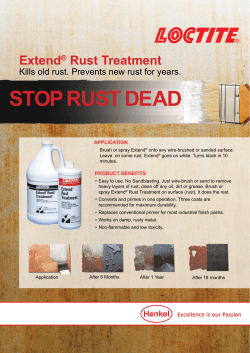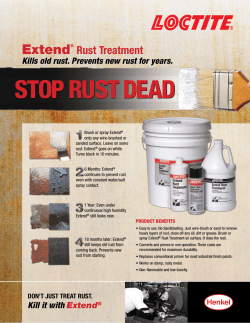
Stripe rust management
Stripe rust management for wheat in 2004 & 2005 Barry Haskins & Guy McMullen N S W D e p a r t m e nt of P r i m a r y I n d u st r i e s IN A NUTSHELL w Selecting wheat varieties with stripe rust resistance (rating 7–8) is the most effective form of managing the disease, however the limited number of varieties with the combination of desirable agronomic traits and sufficient resistance will see the continued need for fungicide control strategies w Yields of H45 (very susceptible to stripe rust) were maximised by keeping the crop free from disease until flag emergence and, most critically in high yielding situations, following up with a foliar fungicide w Responses to fungicides (seed, fertiliser and foliar) in Chara (moderately susceptible to stripe rust) were less predictable than for H45 and more strongly linked to higher yield potential w No responses in Sunstate (resistant to stripe rust) were found to any fungicides w Seed and fertiliser dressings tested in the trial gave significantly different protection periods across higher yielding sites – the more resistant the variety, the longer the protection period Since the arrival of the WA pathotype of stripe rust (Puccinia striiformis) to southern NSW, the resistance of many wheat varieties to this strain has reduced. There has been a dramatic increase in the use of fungicides, an estimated $100 million spent on fungicides to control stripe rust in 2005, across Australia. The continued sowing of increasingly susceptible varieties means that stripe rust is likely to continue to be a problem and it also increases the risk of the disease organisms mutating and overcoming resistant varieties. Stripe rust causes severe yield losses when the disease develops and grows on green leaf area, reducing the photosynthetic ability of the plant. Research has shown that losses are dependent on the timing of the infection, the rate of development of the disease and the temperature during grain fill. Merriwagga and an irrigated site at Griffith (Figure 1). A summary of the control strategies is outlined in Table 1. How did the strategies perform? 2004 The incidence of stripe rust was low at all sites in 2004. It was not found in Sunstate at any of the sites. Low levels of infection were found in Chara, while significant levels were found in H45 at the Lockhart and Finley sites only. At Lockhart and Finley, both seed dressings (Baytan® and Jockey®) were found to be effective for managing the Stripe rust management strategies In response to the rapid spread of stripe rust in 2003, a series of coordinated field trials was conducted in 2004 and 2005 in south west NSW to evaluate various management strategies for the disease. The strategies evaluated included the use of resistant wheat varieties, fungicide dressings on seed and fertiliser, and a targeted foliar fungicide near flag emergence (wheat growth stage Z39). w In 2004 field trials were located at 10 sites (Lockhart, Finley, Deniliquin, Hay, Merriwagga, Griffith, Weethalle, Condobolin, Tottenham and Dareton). In 2005 trials were located at Oaklands, Lockhart, Weethalle, Quandialla and 18 IREC Farmers Newsletter, No. 172, Autumn 2006 Figure 1 A series of trials was set up in south west NSW to evaluate stripe rust control strategies, including this site in an irrigated wheat crop at Griffith stripe rust management disease levels in H45 and Chara, even though disease pressure was low. Despite better control of stripe rust with the combination of fungicides (as dressings and foliar) and the use of resistant varieties, there was no significant increase in grain yield in these varieties compared with Sunstate, the more resistant variety. There was also no response to any fungicides in barley. 2005 The 2005 season was on average warm throughout and combined with the wet spring, was perfect for the development of stripe rust. Disease level at most sites was high. Disease level at flag leaf emergence The trials in 2005 showed that the use of resistant wheat varieties can eliminate the need for seed, fertiliser or foliar fungicides. The levels of disease found in Sunstate and Chara (Figure 2) were much lower than those found in H45 (Figure 3) at all the sites. Across all the sites (excluding Merriwagga and Weethalle), the disease levels in H45 at flag emergence (Z39) were reduced by using Bayleton® on the fertiliser, and Jockey and Baytan on the seed. The response using the same fungicides in Chara was much less predictable, and seemed to be correlated to the timing of infection and yield potential, where crops with early infection and high yield potential showed an increased yield when using these fungicides. Bayleton on fertiliser was observed to give the greatest reduction in disease levels although levels were still greater than 5% in H45 at GS39 (the level which would trigger the need for a foliar fungicide). This shows that even the best fungicide at sowing in this trial didn't give adequate protection in H45 before flag leaf emergence. The poor efficacy of Impact® on fertiliser was unexpected and not typical for this fungicide and is currently being investigated. Surprisingly Impact gave excellent protection against scald and powdery mildew in Schooner barley. Figure 4 shows the disease levels for the treatments at the Griffith site. Table 1 Wheat varieties, seed and fertiliser dressings and foliar fungicides used in the stripe rust management trial series Mangement option Variety/Product Resistance rating/Active ingredient & rate Wheat variety H45 Chara Sunstate 1 (VS - very susceptible) 3 (S-MS susceptible to moderately susceptible) 8 (R - resistant) Barley variety Schooner (looking at powdery mildew and scald) Seed dressings Baytan T® 150 g/L Jockey® 167 g/L Triadimenol 150 mL/100 kg seed Fluquinconazole 450 mL/100 kg seed Fertiliser dressings Impact® 250 g/L* Bayleton® 125 g/L ECA* Flutriafol 400 mL/50 kg MAP Triadimefon 800 mL/50 kg MAP Foliar @ Z39 Bayleton® 125 g/L EC Optus® 125 g/L ECB Triadimefon 1L/ha Epoxyconazole 500mL/ha *treatments only used in 2005 A Bayleton® 125EC is not currently registered as a fertiliser dressing for stripe rust in NSW. Triadimefon 125EC was used in accordance with the registration in WA. Powder triadimefon was not used due to potential health risks. B Opus® used at Griffith irrigated site only with 200 mL Chemwet/100 L water. Chara with no fungicide control at flag leaf emergence Figure 3 H45 with no fungicide control at flag leaf emergence IREC Farmers Newsletter, No. 172, Autumn 2006 w Figure 2 19 stripe rust management Yield response The yield response to fungicides at all sites depended on the variety, the timing and level of infection, and the yield potential.potential. No increase in yield by applying either seed, fertiliser or foliar fungicides occurred at both Merriwagga and Weethalle. This was because there was a very low incidence of disease and low yield potential at both sites. The average Figure 4 yield across all treatments at these sites was 2.3 and 1.0 t/ha, respectively. At Lockhart we were able to increase yield by using Baytan, Jockey and Bayleton on the fertiliser. We didn't however measure an increase in yield by applying Bayleton as a foliar, possibly because of the high disease levels at application. This highlights the need for the crop to be clean when applying a foliar fungicide in order to maximise Disease scores showing percent leaf area infection at flag leaf emergence (GS39) in both wheat and barley at the Griffith site. In wheat the disease was stripe rust, and in barley powdery mildew and scald. * Note that leaf area infection includes both lower and upper leaves in the canopy, and is measured in the worst section of the trial plot. w Figure 5 20 H45 with Bayleton® on fertiliser and 500 mL/ha Opus at flag emergence, yielded 5.7 t/ha IREC Farmers Newsletter, No. 172, Autumn 2006 Figure 6 H45 control (no treatment at sowing) with 500 mL/ha Opus at flag emergence, yielded 4.4 t/ha stripe rust management potential yield. The average yield at this site was 3.85 t/ha. Early prevention is critical At Griffith, Oaklands and Quandialla yields were 4.4 t/ha, 4.2 t/ha, and 3.5 t/ha respectively and there was high disease pressure. At these sites, the most consistent and effective management strategy for stripe rust in H45 was the combination of Bayleton on the fertiliser with an application of a foliar fungicide near flag leaf emergence. Figures 5 and 6 show the difference in crop growth with and without the initial treatment. The prevention of early infection is critical for maintaining yield potential in any strategy that aims to manage stripe rust in wheat. A disease-free plant at flag leaf emergence will allow a maximum yield response to foliar fungicides. This combined treatment of fungicide at sowing and a foliar fungicide at flag leaf emergence, in turn enables wheat varieties susceptible to stripe rust to achieve their yield potential. The response to using seed, fertiliser and foliar fungicides in Chara was much less predictable because of the small amount of adult plant resistance the variety showed following flag leaf emergence. In most cases it was worthwhile adding either Baytan or Jockey to keep the crop clean if an early infection occurred, and following up with a foliar fungicide. Given the sporadic nature of stripe rust, in paddock situations similar to what was experienced at these sites, it would be good practice to apply a seed or fertiliser fungicide followed by a foliar fungicide at flag leaf emergence. Trials from 2004 and 2005 have shown that the use of Bayleton on fertiliser, or Jockey or Baytan on seed, gave sufficient early protection of stripe rust until flag emergence, especially when used with varieties with some resistance. The length of protection from these fungicides decreased in H45 under high disease pressure. In some situations a foliar fungicide spray before flag emergence in H45 may be warranted, followed by a second foliar fungicide application later in the season. No response to any fungicide at any site was observed for Sunstate. In Schooner barley, the only site which showed a yield benefit by fungicides was Griffith, where disease levels were minimised, and yield was significantly increased by applying either Jockey or Impact. The yields of all treatments at the Griffith site are shown in Figure 7. Varieties that are very susceptible to stripe rust (such as H45) may also require foliar fungicide application prior to and after flag leaf emergence. Varieties that are resistant to highly resistant to stripe rust will not require any fungicide treatment at all. However, these varieties should be closely observed in high disease years to ensure mutating strains of the disease do not take effect. Yields in all varieties and treatments with and without a foliar application of Opus® at flag leaf emergence (GS39), at the Griffith site IREC Farmers Newsletter, No. 172, Autumn 2006 w Figure 7 In summary, the trials have shown that early prevention of stripe rust with a seed or fertiliser dressing is critical when sowing wheat varieties with moderate to high susceptibility to the disease. 21 stripe rust management GRDC Project: DAN396 "WESTERN WHEAT" Identifying productive, profitable and sustainable farm practices for low rainfall districts of south west NSW. Acknowledgements Many thanks to the cooperating farmers for hosting the sites and Elio Minato, NSW DPI for preparing the trial packs. Thanks to Bayer CropScience, CropCare, Crompton Crop Protection, FarmOz and NuFarm for providing the fungicides. Also thanks to Gordon Murray and Kerry Wratten of NSW DPI for technical advice and assisting with disease scoring. The following DPI District Agronomists also contributed to the trial: Matt McRae, Andrew Schipp, Rachael Whitworth, Bob Thompson, Nathan Border, Alex Murray and Lisa Castleman Further information w Barry Haskins District Agronomist Hillston, NSW DPI T: 02 69 601 320 M: 0427 007 418 E: barry.haskins@dpi.gov.nsw.au 22 IREC Farmers Newsletter, No. 172, Autumn 2006
© Copyright 2025









